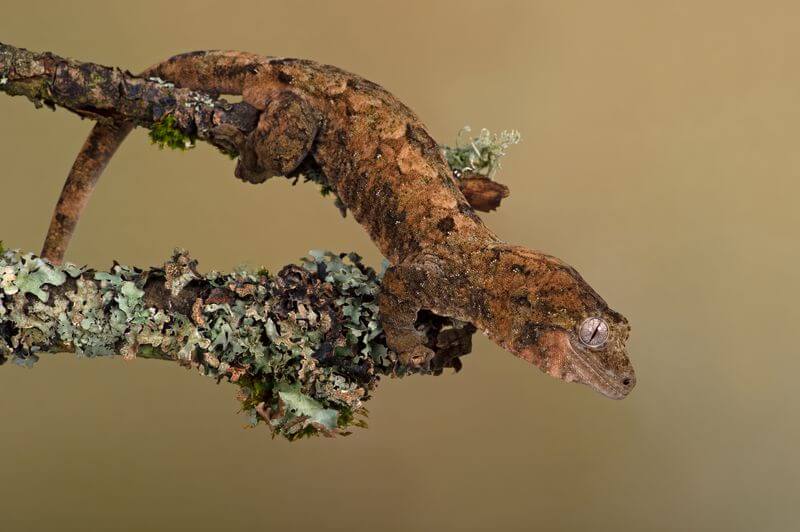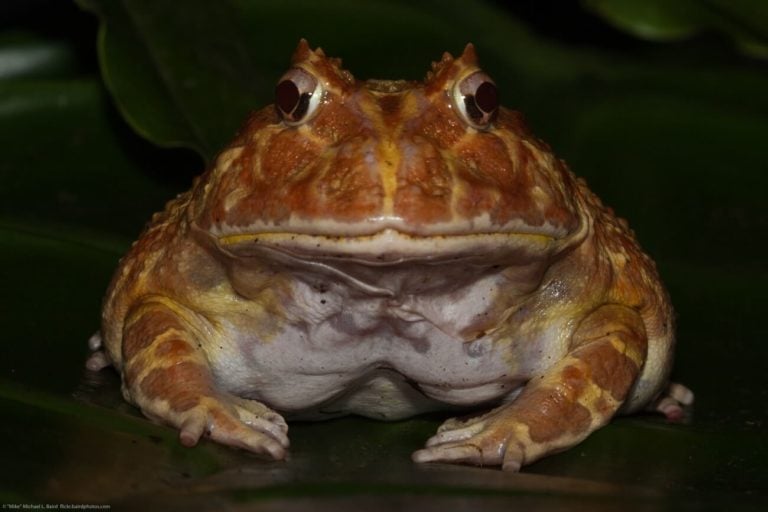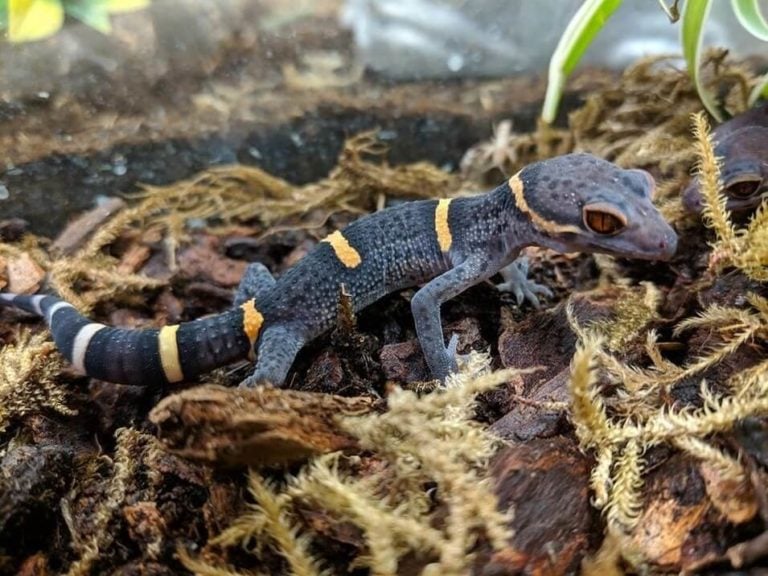Chahoua geckos are interesting little critters that make for great pets. But unfortunately, there’s a lot of misinformation floating around online about them!
This guide will teach you everything you should know about chahoua gecko care. You’ll learn about their diet, enclosure setup, size, lifespan, and more.
Table of Contents
Species Summary
The chahoua gecko (Mniarogekko chahoua) is a beautiful, beginner-friendly reptile native to New Caledonia. Thanks to its distinct looks and relatively hardy nature, it’s one of the more unique gecko species in the pet trade.
In the wild, chahoua geckos live in the trees of New Caledonia, a chain of islands in the Pacific Ocean. Most of the geckos reside on the biggest archipelago island, Grande Terre. However, some also live on the nearby Isle of Pines.
Unfortunately, wild chahoua geckos are considered vulnerable animals by the International Union for Conservation of Nature (IUCN). Therefore, the wild population isn’t as prolific as it once was. On the plus side, chahoua geckos are still widespread in the pet trade.
They make wonderful pets, and many herpetology buffs consider the species a great option for beginners. While they have distinct needs like any other type of gecko, this species has more straightforward care requirements and are hardy enough to remain healthy in a well-maintained captive environment.
Appearance & Colors
Chahoua geckos don’t look like your average gecko!
First, their bodies have unique coloration. They are an arboreal species that roam the treetops most of the day. As a result, they have high-camouflage coloration.
Most chahoua geckos have various shades of brown and gray. They look like leaf litter! However, exact coloration can vary based on where the gecko comes from. You might see shades of red, green, white, and dark brown.

Like other gecko species, the chahous have sticky toe pads for climbing. The toes also have claws for protection and better grip.
The tail is thick and muscular. It’s a prehensile tail, so the geckos will cling to climbable branches and maintain balance as they navigate their natural surroundings.
The gecko’s head is one of its most defining features. Chahous have prominent, triangular-shaped heads. The snout is short and blunt. Meanwhile, the eyes are large and lidless.
Most chahoua geckos have light-colored eyes that stand out against the color of their velvet-like skin. They’re also sporting vertical pupils that change based on lighting conditions.
Expert Tip: Males and females are difficult to differentiate during the juvenile phase. However, as the geckos reach maturity, differences become more known. Males develop a bulge between their rear legs, while females don’t.
Average Chahoua Gecko Size
Chahou geckos are a medium-sized species. Adults are typically between 10 to 12 inches long from tail to snout.
Most of that length goes to their tail. The gecko’s core, from snout to vent, is only about five and a half inches long.
These geckos start their lives much smaller. They’re only about an inch to an inch and a half after hatching. When you see them in pet stores, they may only be a few inches long. However, the lizard grows significantly during the first year. Most geckos will reach their mature size after about 18 months.
Lifespan
If you plan on getting a chahoua gecko, be prepared for many years of care! Chahoua geckos have an average lifespan of 15 to 20 years.
There are no guarantees, as these geckos are susceptible to health and genetic issues like any other living creature. The best thing you can do is provide a healthy diet, a well-maintained enclosure, and top-notch care to keep your gecko as healthy as possible for many years to come.
Chahoua Gecko Care
This gecko species is a joy to take care of. They’re an interesting-looking species with plenty to offer. Chahoua geckos are also quite docile and can develop great bonds with their owners.
A fantastic beginner-friendly species, chahoua geckos are easy enough for most people to care for without major issues. But like all pets, they have distinct care requirements you need to meet.
Here are some tips to make chahoua gecko care a breeze.
Enclosure Size
Establishing a healthy and enriching environment is the most challenging aspect of caring for any lizard. This gecko lives in the tropical jungles of New Caledonia. They thrive in humid environments full of lush vegetation.
When caring for a chahoua gecko, your goal is to recreate that habitat in captivity.
The first thing you’ll need is an enclosure that fits them. Because they’re larger than smaller lizards, they need a good amount of space to stay happy and healthy. Furthermore, you must consider their arboreal nature.
A standard glass tank won’t do. Chahoua geckos need vertically oriented terrariums that measure at least 36 inches long, 18 inches wide, and 36 inches tall. You can go even bigger to create as much living space as possible.
Juveniles do fine in smaller quarters. They can do well in a square terrarium that measures 12 inches in all dimensions. However, you’ll need to quickly upgrade to something bigger as they approach maturity.
The best terrariums will feature glass walls. Geckos use sticky toe pads to climb the glass, so you’ll also need a tight-fitted lid to secure your lizards. Choosing a terrarium with front-facing doors is also wise so you can easily reach in for handling, feeding, and cleaning.
What To Put In Their Habitat
Decorating your chahoua gecko’s habitat is a must. A bare-boned terrarium won’t do. These lizards need a lush environment with plenty of enrichment.
On the bottom of the terrarium, add a two-inch layer of substrate. Chahoua geckos are arboreal, so they don’t spend much time at the bottom of their enclosure. However, a good substrate will help maintain environmental conditions.
The best substrates retain moisture. Absorbent materials like reptile-safe topsoil are best. You can easily source premade soil mixes at your local pet store. Whatever you choose, make sure it’s made for reptiles and contains no fertilizers or chemical additives.
On top of the substrate, add a few clumps of leaves. You can also add sphagnum moss. Both materials are reminiscent of the jungles they come from, adding to the natural appeal.
Next, you can move on to enriching decorative items.
The most important decorations you’ll need are climbing surfaces. Consider adding a large piece of bark to the back of the terrarium to serve as a climbable backdrop. Then, arrange climbing branches and vines.
Branches of cork bark or Cholla wood do best. Arrange them diagonally throughout the tank to give your gecko plenty of places to explore. The same goes for vines.
You can install faux plants and hollowed-out cork logs toward the bottom of the tank. The logs will serve as a hide box. Meanwhile, the plants will give your gecko a place to explore and get away from view whenever they need to sleep.
Don’t be afraid to get creative! Add a mix of plants and decor to create a tropical jungle in the confined space of a terrarium.
Temperature & Lighting
Chahoua geckos are cold-blooded creatures which means their body temperature doesn’t regulate as it does in mammals. As a result, these creatures must thermoregulate by moving to different temperature zones.
Your gecko’s enclosure needs a stable temperature gradient with a cool, warm, and basking zone.
On the cooler end, ambient temperatures should be between 72 and 75 degrees Fahrenheit. At night, temperatures can fall to around 65 degrees. But if you live in a much colder area, install under-tank heating pads or emitters.
A standard full-spectrum lighting rig will take care of temperatures throughout the day. Set the lights on a timer and install a thermometer to keep tabs on the temperature throughout the day.
On the opposite end of the tank, install a basking light. The best place to position the light is above the terrarium but not touching the glass. You can focus the light on one climbing spot, creating a natural temperature gradient from the top down.
The basking area should be between 82 and 85 degrees Fahrenheit. Any hotter than that, and your gecko could experience health issues. That basking spot has a relatively low temperature compared to the needs of other reptiles. As a result, you can often use a low-powered basking lamp instead of the stronger models.
Chahoua geckos are a nocturnal species. You don’t need any specialty UVB lamps. Some herpetology enthusiasts install low-level UVB lamps for good measure, but the addition is optional.
Remember to set all lights on a timer. Your geckos still need a day and night cycle to maintain their circadian rhythm. If you want to see your geckos when they’re most active, consider installing an infrared lamp for nighttime use.
Humidity
Next to temperature, humidity is the most important environmental factor to maintain when it comes to chahoua gecko care. The jungles where these lizards reside in the wild are very humid. So, you must create something similar in captivity.
The ideal relative humidity level for the chahoua gecko is 60 to 80 percent. That’s a wide range, so most owners don’t have trouble maintaining it. Even still, it’s wise to install a hygrometer to always keep tabs.
Your substrate will do much of the heavy lifting. You can spritz the substrate with clean water if you need to increase humidity levels. Do that as needed, and you should be fine.
Alternatively, you can install an automatic mister or humidification unit inside the tank. If the humidity gets too high, open up vents in the terrarium to increase airflow.
Water
Most chahoua geckos stay hydrated through humidity. They might drink water droplets from faux plants, too.
However, it’s still important to provide a water dish. You can install a water dish at the bottom of the terrarium or on a feeding ledge. Your lizard might lap up water occasionally or use the dish to soak.
Change the water every day and spot clean messes as they occur. Disinfect the bowl at least once a week with a reptile-safe sanitizing product.
Food & Diet
Chahoua geckos are natural omnivores. They thrive with both plant-based and protein-based foods.
The easiest diet will consist of live insects and premade gecko food. Food for the more common crested gecko will do. These products are nutritionally balanced and give your lizard everything it needs to stay healthy.
Purchase a feeding ledge you can install on the terrarium’s glass. Chahoua geckos aren’t keen on eating from the ground.
The best way to feed a chahoua gecko is to alternate between commercial gecko food and live insects. Juveniles will need to eat gecko food daily with insects every other day. However, adults can eat bigger meals and feed less often, eating three to four times a week with live insects every other day.
Crickets are the most common feeder insect available, but chahoua geckos also accept Dubia roaches, mealworms, waxworms, super worms, and grasshoppers. Always source feeder insects from breeders or pet stores. They should be gut-loaded for safety.
You also need to dust live insects in calcium and multivitamin supplements. Supplement powders ensure that your gecko gets all the essential vitamins and minerals they may not get through their food.
Potential Health Issues
Fortunately, chahoua geckos are pretty hardy and rarely experience health problems. However, they are susceptible to certain conditions if environmental conditions aren’t right.
Your biggest worry is metabolic bone disease. This disease occurs when a gecko doesn’t get enough calcium and Vitamin D in their system. The bones eventually become brittle, making them prone to fractures.
It’s a painful disease that will lower your chahoua gecko’s quality of life and lifespan. Avoid it by always dusting insects with multivitamins and calcium powder before feeding.
Parasites and bacterial infections are another concern. Parasites usually occur when exposed to infected animals. That’s why getting your gecko from a reputable breeder or pet store is important.
Infections happen when bacteria take the terrarium over. Depending on the type of bacteria present, your gecko could experience respiratory problems, inflammation, and more.
Infections become problematic when humidity and temperature aren’t stable, so invest in a thermometer and hygrometer to maintain a healthy environment. Infections can also occur when you don’t clean the tank.
Spot clean messes every day. Then, do a deep clean once a month. During a deep clean, replace the substrate, remove every decor item, and wipe down every surface with a reptile-safe disinfectant. Regular cleaning will keep bacteria under control so that your gecko stays healthy.
Behavior & Temperament
For the most part, chahoua geckos are easygoing. They can be skittish initially, but most will get comfortable the longer they stay in their environment.
It’s best to keep only one chahoua gecko in the enclosure. This species can become territorial. Unless you have a massive terrarium, infighting can become an issue.
Throughout the day, chahoua geckos usually lounge and sleep. They may rest on a lower branch hidden among plants. Sometimes, they may venture to the bottom to use one of the hollowed-out logs.
Once the sun sets, these geckos become more active. They’ll climb around the decor and explore every inch of the enclosure.
Handling Them
Chahoua geckos tolerate handling well. However, you must gain your gecko’s trust first.
Give the lizard a few weeks to adjust to its new surroundings before slowly introducing yourself. Begin by placing your hand in the enclosure for a few minutes during nighttime hours.
Over time, your chahoua gecko will get comfortable with your scent and presence. That’s when you can begin handling it. Start by handling your gecko briefly before gradually working your way up.
Always support your gecko’s weight and learn to read their body language. If they show any signs of stress, put your gecko back into the enclosure. This species can drop its tail, so you must avoid stressing them out in any way.
Closing Thoughts
Anyone can provide their chahoua gecko with excellent care if they set aside the right amount of time. These lizards aren’t high-maintenance, so we’re confident that you’ll find success if you stay dedicated.
We’d love to hear your thoughts about this lizard. Send them over and we’ll connect with you as soon as we can!


